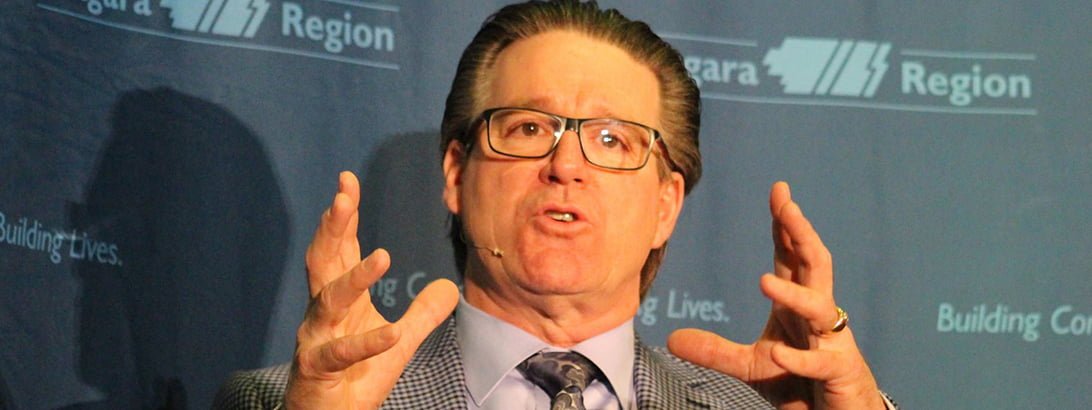A call from business leaders for one level of government in Niagara came as no surprise to Brian Heit.
“I’ve been dealing with these business people for 25 years, I’ve known that,” the longtime regional councillor from St. Catharines said Wednesday.
“I’ve sat at city council. I’ve known that if we want to achieve something great for Niagara, we really need to speak with one voice, not be 13 voices.”
At a roundtable discussion Tuesday at Niagara Region headquarters in Thorold between Chair Alan Caslin, budget head David Barrick, audit committee chair Tony Quirk and business leaders, the politicians were told the future success of Niagara lies with the elimination of lower tiers of government.
Business leaders Tom Rankin, Spencer Fox, Mark Sherk, George Darte and Larry Vaughan called on elected officials to demand the province eliminate the lower tiers of government in favour of an amalgamated City of Niagara.
They said the multiple levels of government and their bureaucracies are a roadblock to keeping and attracting businesses to Niagara and the duplication of services between the 12 municipalities and regional government is a major stressor on property taxes.
“That’s the belief I have,” Heit said.
“That’s the reason I came up to the Region to try do (create one Niagara). I believe that that is our salvation. That that’s how we’re going to achieve greatness, by being one Niagara.”
Former regional councillor and regional chair Debbie Zimmerman said one Niagara is a goal “they should definitely be working toward.”
She said the business community has long complained about having to deal with multiple levels of government and bureaucracy.
“You’ve got to take a serious look at what the business community has been saying for some time,” she said. “Thirteen administrations is just not sustainable.”
With one Niagara as the goal, by way of an example she cited municipal transit as an area where dollars could be saved on the road to amalgamation.
“Do we need nine transit structures in this region — and that’s what we have currently. No,” she said.
“It starts with some of the simple things we’ve had on the table for a long time. I don’t think that there’s going to be any wholesale dismantling of the municipalities, but it is getting to that focused drive to reduce these number of level of services we have for the same thing.”
Caslin said Wednesday he heard the businesspeople’s argument clearly.
“I heard the message loud and clear from them as to what they wanted, and that was the elimination of waste, the reduction of costs,” Caslin said.
“They talked about several methods, including amalgamating Niagara, but what was important and what I took from that was their desire to get taxes reduced and elimination of waste.”
Caslin said the issue of amalgamation should be left with the community.
“It doesn’t need to be Al Caslin’s opinion, it needs to be the opinion of the community, and that question hasn’t even been broached yet.”
Dolores Fabiano, executive director of the Niagara Falls, Welland, Pelham and Port Colborne-Wainfleet chambers of commerce, said amalgamation isn’t a simple black and white issue in which it is clear there are cost savings.
“It’s not that clear cut,” Fabiano said.
“For immediate results, are there opportunities for us to start sharing services with the municipalities? Maybe that’s an area we need to be exploring right now. Amalgamation may be the way we need go, but I guess the point is it does nothing for us right now.
“You can look at some of the other communities that did amalgamate — were there cost savings? Weren’t there cost savings?”
Fabiano’s counterpart at the Greater Niagara Chamber of Commerce, Mishka Balsom, said her chamber’s position, rather than amalgamation, is collaboration.
“Our position currently is that we do have to collaborate,” she said. “The businesses in Niagara want to collaborate and come together on specific issues. Specific issues might be transportation, it might be how to increase our competitiveness.”
Barrick said amalgamation is a provincial matter, but noted “it’s something to consider.”
“I don’t think residents care who delivers the services, as long as it’s delivered effectively and efficiently …. I think that’s a conversation we need to revisit, based on this conversation,” Barrick said following the roundtable talk, in which more than 20 business people took part.
Regional council newbee Quirk, who previously served on Grimsby council, said there are costs associated with amalgamation to consider, such as the hiring of firefighters to service areas in Niagara currently covered by volunteers. But there is room for “rationalization and elimination of overlap, he said.
“I think the biggest point that (business leaders) were making was that they’re really upset about their tax rates,” Quirk said.
“And they see (amalgamation) as a possible solution to solve that problem. And I think what we can do this term is try to eliminate waste, try to keep taxes low, and if they see that we can lead by example and work more collaboratively with our municipalities to eliminate overlap … if they see we are eliminating waste, that we’re keeping taxes low, that we’re eliminating duplication, I think they’ll be equally happy.”
rob.houle@sunmedia.ca
Twitter: RobH_Standard
Original article: http://www.stcatharinesstandard.ca/2015/06/24/mixed-reaction-to-call-for-one-niagara



